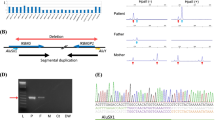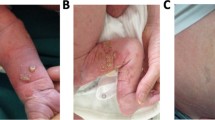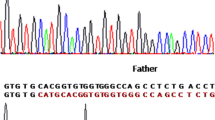Summary
We report two unrelated girls who present some clinical features of severe incontinentia pigmenti (IP), with characteristic skin pigmentation. Both have balanced de novo X/autosome translocations involving band Xp11. The coincidence of the probable de novo expression of an X-linked disorder in these two girls with translocations involving similar breakpoints on the X chromosome suggests that this band may be the site of the IP gene locus.
Similar content being viewed by others
References
Bawle E, Tyrkus M, Lipman S, Bozimowski D (1984) Aarskog syndrome: full male and female expression associated with an X-autosome translocation. Am J Med Genet 17:595–602
Bjerglund-Nielsen L, Nielsen I-M (1984) Turner's syndrome and Duchenne muscular dystrophy in a girl with an X;autosome translocation. Ann Genet (Paris) 27:173–177
Camargo M, Cervenka J (1984) DNA replication and inactivation patterns in structural abnormality of sex chromosomes. I. X-A translocations, rings, fragments, isochromosomes, and pseudoisodicentrics. Hum Genet 67:37–47
Canki N, Dutrillaux B, Tivadar I (1979) Dystrophie musculaire de Duchenne chez une petite fille porteuse d'une translocation t(X;3) (p21;q13) de novo. Ann Genet (Paris) 22:35–39
Carney RG Jr (1976) Incontinentia pigmenti. A world statistical analysis. Arch Dermatol 112:535–542
Emanuel BS, Zackai EH, Tucker S (1983) Further evidence for Xp21 location of Duchenne muscular dystrophy (DMD) locus: X/9 translocation in a female with DMD. J Med Genet 20:461–463
Gilgenkrantz S, Tridon P, Pinel-Briquel N, Beurey J, Weber M (1985) Translocation (X;9)(p11;q34) in a girl with incontinentia pigmenti (I.P.): implications for the regional assignment of the I.P. locus to Xp11? Ann Genet (Paris) 28:90–92
Greenstein RM, Reardon MP, Chan TS, Middleton AB, Mulivor RA, Greene AE, Corriell LL (1980) An (X;11) translocation in a girl with Duchenne muscular dystrophy. Cytogenet Cell Genet 27:268
Grosshans EL, Stoebner P, Bergoend M, Stoll C (1971) Incontinentia pigmenti achromians (ITO). Etude clinique et histo-pathologique. Dermatologie 142:65–78
Haber H (1952) The Bloch-Sulzberger syndrome (I.P.). Br J Dermatol 64:129–140
Hecht F, Hecht BK (1983) The half chromatid mutation model and bidirectional mutation in incontinentia pigmenti. Clin Genet 24:177–179
Hecht F, Hecht BK, Austin WJ (1982) Incontinentia pigmenti in Arizona Indians including transmission from mother to son inconsistent with the half-chromatid mutation model. Clin Genet 21:293–296
Hellkuhl B, de la Chapelle A, Grzeschik KH (1982) Different patterns of X chromosome inactivity in lymphocytes and fibroblasts of a human balanced X/autosome translocation. Hum Genet 60:126–129
Hodgson SV, Heckmatt JZ, Hughes E, Crolla JA, Dubowitz V, Bobrow M (1985) A balanced de novo X/autosome translocation in a girl with manifestations of Lowe syndrome. Am J Med Genet (in press)
Jacobs PA, Hunt PA, Mayer M, Bart RD (1981) Duchenne muscular dystrophy (DMD) in a female with an X/autosome translocation: further evidence that the DMD locus is at Xp21. Am J Hum Genet 33:513–518
Jelinek JE, Bart ES, Schiff GM (1973) Hypomelanosis of Ito (“incontinentia pigmenti achromians”). Report of three cases and review of the literature. Arch Dermatol 107:596–601
Lenz W (1961) Zur Genetik der Incontinentia Pigmenti. Ann Paediatr (Paris) 196:149–165
Lenz W (1975) Half-chromatid mutations may explain incontinentia pigmenti in males. Am J Hum Genet 27:690–691
Lindenbaum RH, Clarke G, Patel C, Moncrieff M, Hughes JT (1979) Muscular dystrophy in an X;1 translocation female suggests that Duchenne locus is on X chromosome short arm. J Med Genet 16:389–392
MacLeod PM, Holden J, Masotti R (1983) Duchenne muscular dystrophy in a female with an X-autosome translocation. Am J Hum Genet 35: 104A
Madan K (1983) Balanced structural changes involving the human X: effect on sexual phenotype. Hum Genet 63:216–221
Mattei MG, Mattei JF, Ayme S, Giraud F (1982) X-Autosome translocations: cytogenetic characteristics and their consequences. Hum Genet 61:295–309
Mossman J, Blunt S, Stephens R, Jones EE, Pembrey M (1983) Hunter's disease in a girl: association with X;5 chromosomal translocation disrupting the Hunter gene. Arch Dis Child 58:911–915
Murray JM, Davies KE, Harper PS, Meredith L, Mueller CR, Williamson R (1982) Linkage relationship of a cloned DNA sequence on the short arm of the X chromosome to Duchenne muscular dystrophy. Nature 300:69–71
Nielsen LB, Jacobsen BB, Nielsen I-M, Tabor A (1983) X;autosome translocation in a girl with muscular dystrophy. Clin Genet 23:242A
Perez-Vidal MT, Grau ES, Vinas JP, Bayona TV, Rustein P (1983) Distrofia muscular tipo Duchenne en una hembra con una translocacion equilibrada X/6. Rev Neurol (Barcelona) 11:155–158
Ropers HH, Zuffardi O, Bianchi E, Tiepolo L (1982) Agenesis of corpus callosum, ocular and skeletal anomalies (X-linked dominant Aicardi's syndrome) in a girl with balanced X/3 translocation. Hum Genet 61:364–368
Smith GF, Sachdeva S, Justice P (1973) A chromosomal break and partial deletion of a no. 9 chromosome. Hum Hered 23:561–567
Turleau C, de Grouchy J, Chabrolle JP (1978) Deletions intercalaires de 9q. Ann Genet (Paris) 21:234–236
Verellen-Dumoulin C, Freund M, de Meyer R, Laterre C, Frederic J, Thompson MW, Markovic VD, Worton R (1984) Expression of an X-linked muscular dystrophy in a female due to non-random inactivation of the normal X chromosome. Hum Genet 67:115–119
Wiklund DA, Weston WL (1980) Incontinentia pigmenti. A four-generation study. Arch Dermatol 116:701–703
Zatz M, Vianna-Morgante AM, Campos P, Diament AJ (1981) Translocation (X;6) in a female with Duchenne muscular dystrophy: implications for the localization of the DMD locus. J Med Genet 18:442–447
Author information
Authors and Affiliations
Rights and permissions
About this article
Cite this article
Hodgson, S.V., Neville, B., Jones, R.W.A. et al. Two cases of X/autosome translocation in females with incontinentia pigmenti. Hum Genet 71, 231–234 (1985). https://doi.org/10.1007/BF00284581
Received:
Revised:
Issue Date:
DOI: https://doi.org/10.1007/BF00284581




